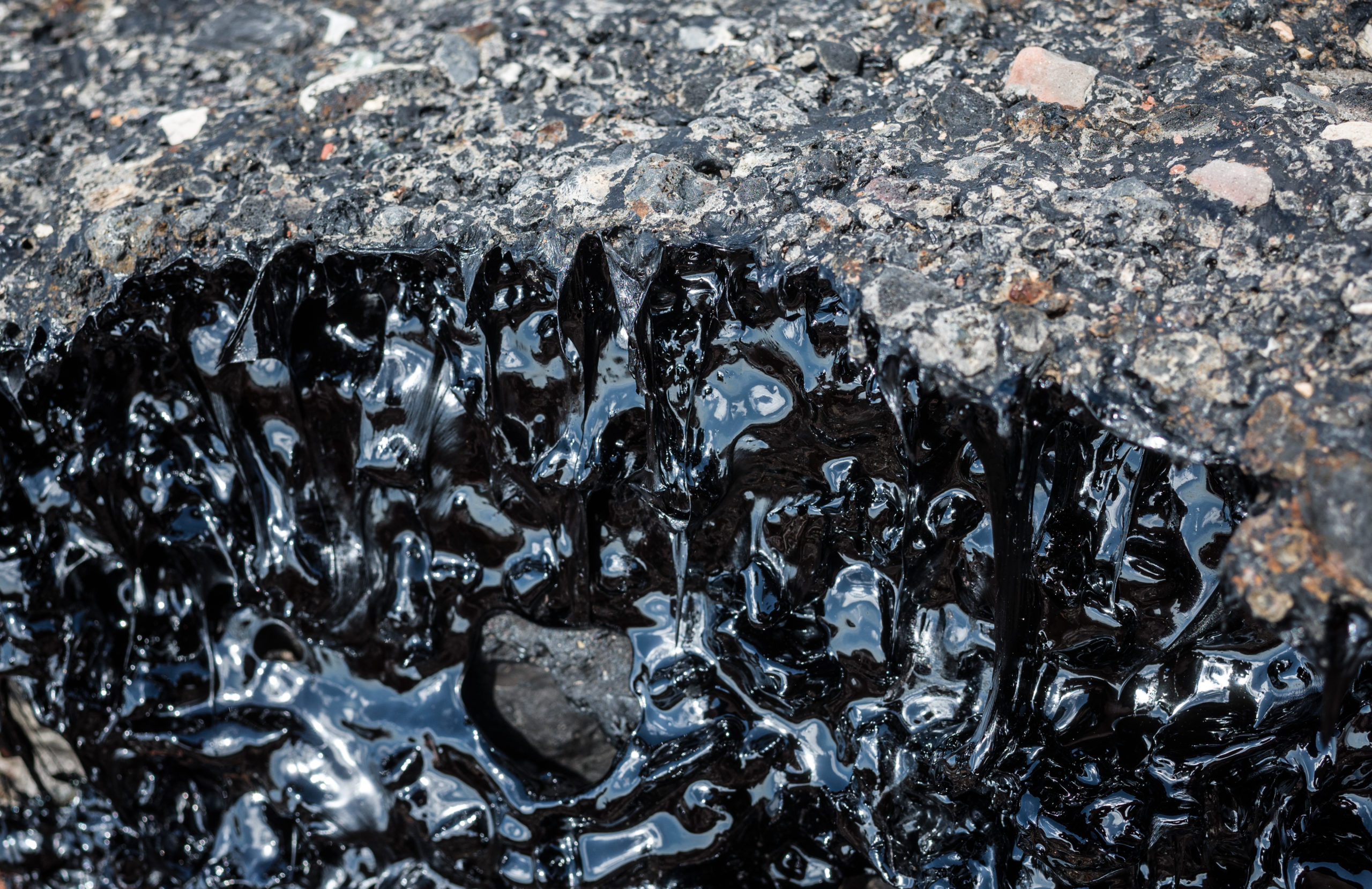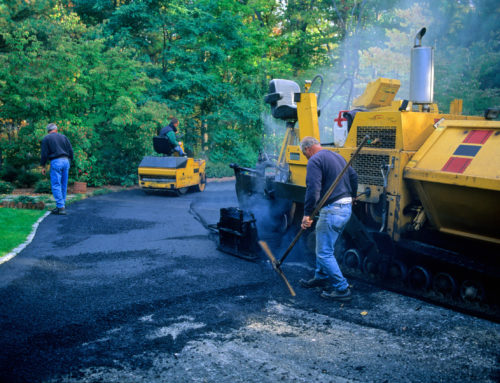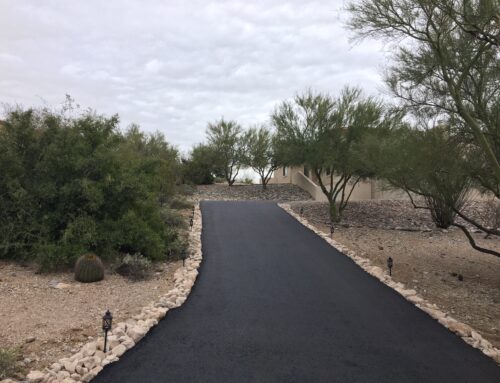Is the summer heat getting to you? We don’t blame ya, Arizona summers are no joke. It might have you pondering strange questions you’ve never thought of before. Things like “You know, we don’t really ever look at the moon do we?” Or “Do raccoons look like burglars, or do burglars look like raccoons?” Or even “What is the melting point of asphalt… Can it become liquid in this heat?” Listen, we can’t help you with those first two, but we sure can answer the third! This time on the Sunrise Asphalt blog, get some peace of mind and learn the melting point of asphalt as well as a few other asphalt temperature tips!
What is the Melting Point of Asphalt?
Asphalt’s melting point in the plant is between ~130 and 343°F. If you’re asking this because you’re worried about your blacktop potentially melting in the Arizona sun – we get it! But thankfully you have to really turn up the heat to get asphalt to melt. The ambient temperature would need to be around 120°F to start ‘melting’ the asphalt in the roads.
When it’s first laid or installed the asphalt is mixed in a drum, at 280°F, then installed (spread and compacted) while still hot. Doing all of this while the material is still warm ensures that the mix of aggregate stone, asphalt binders, and sand, all are still pliable and flexible enough to be spread entirely over the surface and then compacted correctly. If it was too cool the asphalt won’t spread correctly. And that’s no good!
How Cold is Too Cold for Asphalt?
In short? Anything below 50°F is no good for asphalt. Here’s why: as soon as asphalt starts to cool down it will start to cure. Coming down from 280°F to even just 220°F is enough to start the curing process. Once it drops to 185°F it becomes too stiff to be properly compacted. The ambient temperature (the temperature outside, the weather) and the temperature of the ground both play a huge role in managing the temperature of the asphalt. Laying asphalt during the winter for instance can mean the ground is coming in at a much colder temp than other months and when the asphalt is spread it cools faster as the temperature is absorbed by the cold ground. High winds can also cool asphalt fast as the air moving quickly over the asphalt will sap the heat from it.
As soon as asphalt is applied it immediately begins cooling, which is why professional asphalt installers will begin compacting it quickly after it’s poured to ensure the job is done right. If for some reason you’re applying asphalt at home for a small DIY job make sure you’re working in smaller sections to keep the asphalt workable.
What’s the Minimum Temp for Installing Asphalt?
So if that’s too cold. What’s the absolute lowest temperature you can work at? Over 50°F is where you want to start.
What is too hot for asphalt?
Ok, so what’s too hot then? Is there even such a thing? Yes! Asphalt may need to stay warm to stay pliable for installation but if it stays too hot then the asphalt won’t begin to cure as it should, opening it up for damage before it reaches its sturdy state. As mentioned, 120°F is a temp where asphalt may even start to melt! If the ambient temperature is too high, the asphalt won’t hold the binding and cure properly, so delay the installation or repairs until you’re sure the material will have the time and ability to cool as needed! In this case, it’s best to do your asphalt jobs when the temperature is around 90°F.
Ok, What About The Weather? Can You Lay Asphalt When It Rains?
No, you shouldn’t try to pave asphalt when it’s raining. Blacktop’s asphalt and binders that are in it are all oil-based and oil and water don’t mix! Any type of moisture, whether it be rain, snow or even if it’s just really humid, will allow the binders in the asphalt to break apart from the aggregate, causing the asphalt to crumble apart. It can also cause oil in the mix to rise to the surface of the asphalt, staining the surface and causing discoloration. What’s worse? That oily surface increases the risk of damage.
There’s another reason rain can mess with your asphalt surfaces. We’ve talked about it hundreds of times, but water is the enemy of asphalt, causing potholes when the blacktop gets eroded from water moving into cracks and under the surface. Asphalt needs a solid foundation under it so it compacts correctly. Wet ground will let the aggregate base sink and create an uneven surface.
If you have rain, wait until it stops and allow plenty of time for the ground to dry.
What Is the Best Time of Year to Lay Asphalt?
If you know the previous answers this should be pretty easy to pick out based on where you live! It can’t be too hot, too cold, and hopefully with less rain to worry about. In Arizona, we can pave asphalt almost year-round, while other states will find Spring to be the best time to lay down pavement.
What Is the Cure Time for Asphalt?
The cure time for asphalt is how long it takes for the asphalt to set and harden completely. Typically, new asphalt will take anywhere from six months to a full year to cure completely. But don’t worry, you don’t have to avoid driving or parking on it for that long! The initial cure should only take about three full days, maybe a week if it’s exceptionally hot out. After that, you can use the pavement as normal
During that first curing year, however, do avoid parking in the same spot over and over, as the weight of a vehicle concentrating onto the pavement in the same spot repeatedly can cause soft spots. Also, avoid parking near the edges of the asphalt as those places will be more susceptible to damage.
Why Does Asphalt Get So Hot?
So, once the asphalt is paved and cured, why does it get so hot? Two big reasons. One the dark color of asphalt draws in and absorbs a lot of light, and so warms up. The other is that asphalt is so dense that once it has absorbed a lot of heat, it holds on tight to it. This is why asphalt gets hot and stays hot even into the evening.
If your asphalt surfaces need work do not hesitate to contact us to see what you will need, fill out the form to receive your free estimate to understand the likely cost of the job. Until next time, keep your asphalt strong and it will serve you well!



